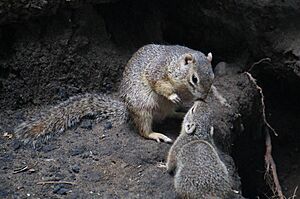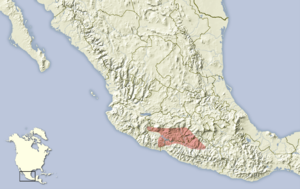Tropical ground squirrel facts for kids
Quick facts for kids Tropical ground squirrel |
|
|---|---|
 |
|
| Conservation status | |
| Scientific classification | |
| Genus: |
Notocitellus
|
| Species: |
adocetus
|
| Synonyms | |
|
Spermophilus adocetus |
|
The tropical ground squirrel (Notocitellus adocetus) is a type of rodent that lives on the ground. It belongs to the Sciuridae family, which includes squirrels. This squirrel is special because it only lives in certain dry, high-up areas and forests in Mexico. People in Mexico sometimes call it Cuinique.
Contents
Understanding the Tropical Ground Squirrel's Name
Scientists group animals together based on how they are related. This helps us understand them better. The tropical ground squirrel was first named Spermophilus adocetus in 1903 by an American zoologist named Clinton Hart Merriam.
Later, in 2009, scientists looked closely at the Spermophilus group of squirrels. They decided to split it into eight new groups, called genera. Each new group had squirrels that looked alike and were closely related. The tropical ground squirrel was then placed in a new group called Notocitellus. This group also includes its close relative, the ring-tailed ground squirrel (Notocitellus annulatus).
What Does the Tropical Ground Squirrel Look Like?
The tropical ground squirrel is smaller than its cousin, the ring-tailed ground squirrel. It has rounder ears and a shorter, wider nose. Its fur is a lighter color, and its tail does not have rings like its cousin's.
Its fur is mostly cinnamon brown with many black hairs mixed in. Its head, upper back, and bushy tail are darker than the rest of its body. The fur on its belly and the inside of its legs is yellowish. It also has faint light streaks above and below its eyes. Female squirrels are about 168 mm (6.6 in) long from head to body, with a tail of about 132 mm (5.2 in). Males are a little bit bigger.
Where Does the Tropical Ground Squirrel Live?
This squirrel only lives in Mexico. You can find it in the states of State of Mexico, Guerrero, Jalisco, and Michoacán. Most of its home is in the Trans-Mexican volcanic belt, in areas that are up to about 3,000 meters (9,800 ft) high.
It likes to live in dry, rocky places like canyons and cliffs. These areas usually have scattered plants, mesquite trees, and barrel cacti. It also lives in forests where trees lose their leaves in certain seasons. Some of these areas have been turned into farms. The tropical ground squirrel has learned to live in these new farm areas and even eats some of the crops.
How Does the Tropical Ground Squirrel Live?
The tropical ground squirrel is a social animal, meaning it likes to live in groups. It is also diurnal, which means it is active during the day. It stays active for most of the year.
It digs complex burrows, which are like underground tunnels. These burrows can be up to 60 cm (24 in) deep and are often found under walls, rocks, or at the bottom of trees.
What Does the Tropical Ground Squirrel Eat?
This squirrel eats many different things, so it is called an omnivore. However, it mainly eats seeds and fruits. It especially likes seeds and fruits from Acacia, Prosopis, Prunus, and Crescentia plants. It also eats green shoots. If it lives near farms, it will eat maize (corn), sorghum, and beans.
It usually gathers food in the morning, between 9:00 AM and 11:00 AM. It stuffs the food into its cheek pouches and carries it back to its burrow to eat later.
Tropical Ground Squirrel Behavior and Reproduction
If food is hard to find during the hottest part of the year, this squirrel might take a short nap called aestivation. This is like a summer sleep to save energy.
In farm areas, it might have babies throughout the year. But in forests, it probably has babies between May and June, before the rainy season starts. The number of squirrels in a group can change a lot from year to year.
In wild places, these squirrels are shy. But when they live near people, they get used to them and become bolder. They might scamper away when humans get close, then watch from a wall or peek out from a crack in a rock.
Even though they mostly eat seeds and fruits in the wild, squirrels in zoos or as pets can eat corn, meat, lettuce, tortillas, and bread. When they eat, they sit on their back legs and use their front paws to push food into their mouths.
Conservation Status of the Tropical Ground Squirrel
The tropical ground squirrel is a common animal in places where it can live. The number of squirrels in its population can change quite a bit each year. It lives in a large area and is thought to have many individuals. The International Union for Conservation of Nature (IUCN) has looked at this species and found no major threats to it. Because of this, its conservation status is listed as "least concern", meaning it is not currently at risk of disappearing.



